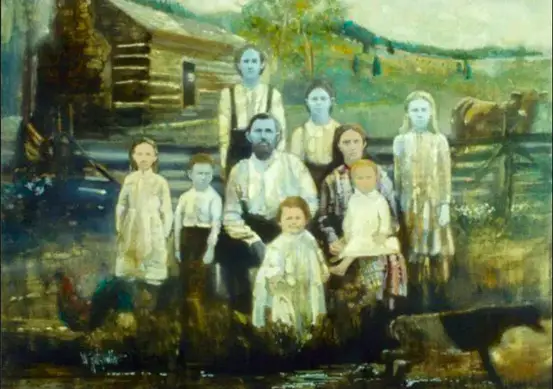 he Fugate family of Kentucky is a well-known family due to a rare genetic condition known as “methemoglobinemia” that caused some of its members to have naturally blue skin. This condition is caused by a genetic mutation that affects the way the body processes hemoglobin, the protein that carries oxygen in the blood. The Fugate family first settled in the Troublesome Creek area of Kentucky in the 1800s. The founder of the family, Martin Fugate, was a French orphan who immigrated to the United States and married a local woman named Elizabeth Smith. The couple had several children, some of whom inherited the genetic mutation that caused methemoglobinemia.
he Fugate family of Kentucky is a well-known family due to a rare genetic condition known as “methemoglobinemia” that caused some of its members to have naturally blue skin. This condition is caused by a genetic mutation that affects the way the body processes hemoglobin, the protein that carries oxygen in the blood. The Fugate family first settled in the Troublesome Creek area of Kentucky in the 1800s. The founder of the family, Martin Fugate, was a French orphan who immigrated to the United States and married a local woman named Elizabeth Smith. The couple had several children, some of whom inherited the genetic mutation that caused methemoglobinemia.
What exactly causes Blue Skin?
The condition is caused by a genetic mutation in the gene that codes for the enzyme diaphorase-1, which is responsible for converting the toxic form of hemoglobin, methemoglobin, back to the normal form. When this enzyme is not functioning properly, the level of methemoglobin in the blood increases, leading to a lack of oxygen being delivered to the body’s tissues. This results in bluish discoloration of the skin, which is a symptom of the condition.
The blue skin of the Fugate family was caused by a specific type of methemoglobinemia known as “Familial methemoglobinemia type 1”, which is inherited in an autosomal recessive pattern. This means that both parents must carry the gene in order for their child to be affected. The Fugates intermarried for generations, which increased the chances of the gene being passed on to their descendants.
Methemoglobinemia is a rare disorder that affects the oxygen-carrying capacity of the blood. It occurs when there is an abnormal amount of a form of hemoglobin called methemoglobin in the blood. Hemoglobin is a protein in red blood cells that carries oxygen to the body’s tissues. Methemoglobin is a form of hemoglobin that is unable to carry oxygen effectively.
Methemoglobinemia can be caused by a genetic mutation, certain medications, or exposure to certain chemicals or toxins. In some cases, the cause is unknown. Symptoms of methemoglobinemia can include cyanosis (bluish discoloration of the skin and mucous membranes), shortness of breath, fatigue, headache, and confusion. In severe cases, it can lead to seizures, coma, and death.
There are different types of methemoglobinemia, each with a different cause. The most common forms are acquired methemoglobinemia and inherited methemoglobinemia. Acquired methemoglobinemia is caused by exposure to certain medications, chemicals, or toxins, while inherited methemoglobinemia is caused by a genetic mutation.
Diagnosis of methemoglobinemia is typically made through a blood test, which measures the amount of methemoglobin in the blood. Treatment for methemoglobinemia varies depending on the cause and severity of the condition. In mild cases, no treatment may be necessary. In more severe cases, treatment may include
The condition was not harmful to the health of the Fugates, but it did make them stand out in their community. The blue skin was a source of curiosity and fascination for many, and the family was often referred to as the “Blue Fugates”. The blue skin condition continued to be present in the Fugate family for generations, with some members of the family being affected and others not.
In the early 20th century, a local doctor named Dr. D.W. Pugh discovered the blue Fugates and began studying their condition. He discovered that the condition was caused by a genetic mutation and that it was inherited in an autosomal recessive pattern. He also found that the condition was not harmful to the health of those affected.
Dr. Pugh’s discovery brought attention to the Fugate family and their condition, and it became a topic of medical research. However, as the Fugates intermarried less and less and the gene pool became more diverse, the incidence of the blue skin condition gradually decreased, and it is now considered to be extremely rare.
History of the Fugate Family
It is important to note that the blue skin condition of the Fugate family is not unique and that similar genetic conditions exist in other populations around the world. These conditions are caused by mutations in the same gene that causes methemoglobinemia,

A French orphan named Martin Fugate moved to the Kentucky town of Hazard in 1820. There, he fell in love with Elizabeth Smith, who he later married and had a family with. According to family history, Martin had indigo-blue skin, which was unusual for men in the area.
They both carried a recessive methemoglobinemia gene, which they were both unaware of and by some bizarre chance. An unusual hereditary disease caused one’s skin to become blue. The fact that they both have this rare genetic feature was pretty peculiar. Elizabeth’s complexion was white, in contrast to her husband, who had dark skin.
Four of the Fugates’ seven offspring had their father’s blue skin color, out of a total of seven. Because residents of neighboring settlements were wary of interacting with the Fugate children, they were forced to live a life of isolation for a very long time. People were wary of being married into the Fugate family because they thought they may end up with blue-skinned kids if it did.
Some of the Fugate descendants married and had children inside their own bloodline as a result of segregation and persecution. Other Fugate relatives were wed by the Fugates. This made room for the “blue skin” gene to continue to be produced. Other Fugate offspring, on the other hand, relocated to various regions of the nation and wed foreigners. Additionally, this enhanced the likelihood that they would pass on the trait and produce additional offspring with blue skin.
The last member of the family to be born with the methemoglobinemia gene is Benjamin Stacy. The doctors were horrified to find a newborn with skin that was so intensely blue when he was born in 1975 that it was practically purple. When his grandmother disclosed that she was descended from the Fugate line, they had just finished testing him and were ready to provide a blood transfusion.
Although Benjamin’s complexion at birth was practically purple, the signs of the genetic disorder lessened as he got older. After a month, his complexion turned rose pink, but on rare occasions, when he felt cold or agitated, he would turn blue.
Avid Writer with invaluable knowledge of Humanity!
Upcoming historian with over 30 million views online.
“You make your own life.”





